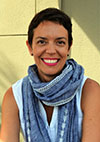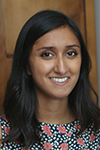Learn about what the PDB archive contains and the resources that RCSB PDB develops to enable breakthroughs in scientific inquiry, medicine, drug discover, technology, and education in the State of the RCSB PDB (PDF). This annual report for 2016 provides an overview of data deposition and annotation, data access, query and reporting, and outreach and education activities.
Learn about what the PDB archive contains and the resources that RCSB PDB develops to enable breakthroughs in scientific inquiry, medicine, drug discover, technology, and education.
The cover image is the painting Insulin Action by David S. Goodsell depicting a 190 nanometer section of a human cell. The hormone insulin (yellow) is shown binding to the insulin receptor (green) thus activating a signaling cascade leading to glucose (white) being transported inside the cells to be used as energy, or to be stored as glycogen (purple). The 2016 poster Insulin and Diabetes built around the painting can be downloaded at pdb101.rcsb.org.
Try your hand at a new Molecule of the Month-related crossword puzzle (HTML and PDF).
In this puzzle, certain clues refer to PDB structure IDs and Molecule of the Month articles. It was created by Charles Deber, a Professor of Biochemistry at the University of Toronto and Senior Scientist in the Research Institute at the Hospital for Sick Children in Toronto. When not researching proteins, his hobbies include constructing crossword puzzles, many of which have been published in the New York Times and other newspapers.
Crystallography is the study of atomic and molecular structure. Crystallographers want to know how the atoms in a material are arranged in order to understand the relationship between atomic structure and properties of these materials. They work in many disciplines, including chemistry, geology, biology, materials science, metallurgy and physics. Crystallographers study diverse substances, from living cells to superconductors, from protein molecules to ceramics.
This book focuses on the diverse 3D shapes and functions of biological molecules studied by crystallography. Crystallographers make these 3D structure data publicly available in online resources like the Protein Data Bank and the Cambridge Structural Database. This broad access helps researchers, educators, and students around the world better understand biology and medicine.
Crystallographers also work together in strong communities. The American Crystallographic Association (ACA) is a non-profit, scientific organization that promotes interactions among scientists who study the structure of matter at atomic (or near atomic) resolution.
This coloring book was created with support from the ACA. Download the booklet or individual pages from PDB-101.
Bulk copies may be requested for use in outreach and education.
At the 12th International Conference on Biology and Synchrotron Radiation (August 21 - 24, SLAC National Accelerator Laboratory), three RCSB PDB Poster Prizes were awarded to:
 |
Ximena Barros-Alvarez |
 |
Avni Bhatt |
 |
Mike Thompson |
Many thanks to the BSR organizers and judges. All 2016 awardees will be listed on the RCSB PDB website and will receive an educational book.
On Friday October 21st 2016, RCSB PDB was part of a unique public symposium that brought together scientists, performance and visual artists, educators, historians, and anthropologists to share their perspectives on this powerful intersection of Aesthetics and the Life Sciences.
This event could not have taken place without sponsorship by Rutgers School of Arts and Sciences, the Center for Integrative Proteomics Research, and the Institute for Quantitative Biomedicine at Rutgers, with additional support from the Wellcome Trust and the Center for Collaborative History at Princeton University. The event was organized by RCSB PDB’s Helen Berman, Stephen Burley, and Christine Zardecki along with Evan Hepler-Smith and Kathryn Maxson Jones (Princeton University).
RCSB PDB’s Cathy Lawson reports:
The morning session was chaired by event co-organizer Evan Hepler-Smith, an Environmental Fellow at the Harvard University Center for the Environment.
Natasha Myers (York University) is the author of Rendering Life Molecular: Models, Modelers, and Excitable Matter (Duke 2015), an anthropologist's perspective on scientists’ use of body-movement-based and machine-based analogies in their studies of molecules and their motions. She reported that crystallographers are apt to humanize their models and express that humanization with their bodies. For instance, “Diane” twisted in pain upon seeing a side-chain in a wrong conformation, exclaiming to her student “What did you do to this side chain?” Another claimed that by determining its structure, it would be possible to tell whether a protein is a welding or drilling machine. Natasha pointed out that anthropomorphic/mechanical descriptions of the “liveliness of molecules” do not often get into publications, but they add an important dimension to molecular descriptions and should be shared more widely.
Jane Richardson (Duke University) drew by hand the very first ribbon diagrams of protein structures that are now standardly shown and produced computationally. In her talk she described the process by which she developed these diagrams, noting that there is no such thing as “photorealism” for the task of representing a complex macromolecule. Her first images simply traced the path of tygon tubing threaded through a brass model (the tubing was filled with a fluorescent dye so it would stand out in the dark). It took Jane another year to figure out how to show alpha-helical ribbons beta strand arrows, smoothed loops, and she shared some of the “tricks” she developed to make the drawings look realistic to the human eye. Later in her talk she drew analogies between architecture and protein structure (Castel del Monte/TIM barrels), between art and protein structure (greek keys on a vase) and between origami (paper folding) and protein folding, showing that even in origami there can be “divergent evolution,” with different paths to creating objects that look very similar.
Julian Voss Andreae (Portland, OR) created the sculpture “Synergy” that stands in front of Rutgers Proteomics, depicting collagen. Julian began his career as a quantum physicist before becoming a scientist-artist. Early works included representations of alpha-helices and proteins using mitered cut segments from steel beams. Inspired by Leonardo da Vinci, his sculpture (“Angel of the West”) replaces the human within a circle with an IgG molecule. He has integrated science and technology in innovative ways into his designs, using computational tools and drawing from his roots.
Molecular animator Janet Iwasa (University of Utah) described “visualizing a hypothesis.” While in graduate school studying actin cytoskeleton at cellular level, she took animation classes and used her newfound skill to create to create molecular movies. She found that 3D animation can synthesize diverse biological data including structures, activity, dynamics, and localization. Her postdoctoral project involved an attempt to visualize early cells, with just a membrane and catalytic RNA, and resulted in a display at the Museum of Science in Boston, and a website exploring life’s origins. She highlighted the fact that for any given animation decisions must be made on how to fill in “missing” data, and this typically requires many conversations with a collaborator/expert. New evidence may require changes to an existing animation. Currently, Janet is developing animations related to HIV.
Julia Buntaine (Rutgers Artist in Residence) creates art inspired by neuroscience, such as a jellyfish made from EEG hardware with embedded LEDs (“EEGellyfish”). “For Pollock” (work in progress) uses neuron mapping data with a Pollock-like color scheme. She pointed out it was not so unusual to be an artist and a scientist in the Renaissance period, but now it is more unusual. Julia is the founder of the SciArt company in NYC, a center that represents sci-artists, promotes events, and produces a magazine. She is passionate about adding an “A” for art into STEM (STEAM = STEM x Art) and is supporting a student-led effort to ignite communications between disparate fields in academia, business, and thought.
RCSB PDB’s Maria Voigt reports:
The afternoon session was chaired by event co-organizer Kathryn Maxson Jones, a PhD Candidate in the History of Science at Princeton University.
The first speaker of the session was Alexander Wragge-Morley (University College London). His talk Empirical Science and the Origins of Aesthetics: A Brief Archaeology focused on addressing the subjectivity and objectivity in scientific representation of the Enlightenment era. He used the book by Robert Hooke Micrographia (1665) to illustrate the effort of the Royal Society in the 17th century to represent nature objectively,“as it really is”. Wragge-Morley noted that Hooke, albeit unintentionally, was also invested in the field of aesthetics: he regarded natural things as infinitely beautiful because they were products of divine design. Later, the presenter described Kant's definition of aesthetic judgment as a "subjective universal,” and addressed the shortcomings in defining the encounters with nature in only subjective or objective terms.
Yvan Tina is a PhD candidate at The University of Aix-Marseille and The University of Texas at Dallas. His talk Reflecting on Theatricality Within Art and Artificial Life explored the parallels between theatre as a way to imitate life, and in silico methods in science as manifestations of replicating life in vivo. Tina proposed that with the exponential growth of the technological sciences and materials, artificial life can be used to cultivate realms that allow for renewing and reinventing aesthetic paradigms and theatricality.
A co-presentation by Judith G. Voet (Swarthmore College) and Donald Voet (University of Pennsylvania) provided some behind-the-scenes look at the illustrations used in the highly popular textbook they coedited (Biochemistry). Judith reminisced on their collaboration with the well-known molecular artist, Irving Geis, and his contributions to the popularity of the book. She described how Irving’s greatest desire was to use beauty as a means of explaining science. Later, Donald gave a brief overview of the evolution of visualization methods for imagining protein structures, including Irving’s hand-painted images, contributions of Cyrus Levinthal, who first used computers to visualize proteins, and modern programs that can create complex molecular images in seconds.
A panel discussion on STEAM gave insight into the growing trend of to integrating art into science and technology education.
The panel’s chair, Ruqqayya Maudoodi (Rutgers Mason Gross School of the Arts) shared her observations of the importance of STEM/STEAM. Anne McKeown, a Master Papermaker from Mason Gross School of the Arts, talked then about the objectives of a new Rutgers Arts Online course, Art, Science, and Technology: How to Transform the Human Experience through the Creative Process, stressing that science and technological tools can be used to advance aesthetical expression. Another panel member, George V. Berger (Impeller Studios and Game Design Methodology at Rutgers) presented a synopsis of the upcoming course content. The course will start with an introduction about the importance of creativity, followed by an unit about biological engineering that will help the students explore the interferences of natural vs manmade. The last section will be devoted to addressing the advantages and pitfalls of virtual reality. In conclusion, of the panel presentation, Ryan Reedell from Makerspace in the The Newark Museum, talked about his work with the Maker Spaces in New Jersey and nationally.
An Animated Keynote performance by Dance Exchange followed. For over a decade, Dance Exchange has been immersed in art/science collaborations that have informed beautiful multi-media dance works for the stage, a range of thought provoking community engagement programming, and arts integrated education activities for people all ages. Company members Cassie Meador (Executive Artistic Director), Elizabeth Johnson (Associate Artist & Director of Partnerships), Matthew Cumbie (Associate Artistic Director), Shula Strassfeld (Associate Artist), and Sydney Noelle Parker and Deborah Zanelli Maciel (Adjunct Artists) demonstrated how diverse scientific disciplines can be conveyed through dance and movement.
The interactive, multi-media performance included video excerpts and live performances, an exercise in dance interpretation, and a “dance along” routine.
Musings on art and science intersections described during day from D. Graham Burnett (Princeton University) concluded the symposium.